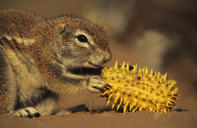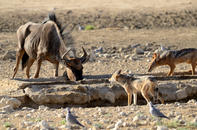Kalahari Flowers and Trees
Tackling the Kalahari in midsummer, when temperatures soar into the high 40s and the ground sizzles above 70°C, may seem a tad crazy. But there are many rewards. It’s a time of broiling skies, green dunes and babies galore. And on the hottest days, the game concentrates around waterholes in large numbers.
Where summer rain falls, you’ll find yellow Devil's thorn flowers and Gifbols showing off their pink blush, or a Vlei lily finally blooming. You’ll also be able to spot Camel-thorn trees that had shed their blossoms.
Two plants are vital to the survival of many creatures in the Kgalagadi: the Tsamma melon (Citrullus lanatus) and Gemsbok cucumber (Acanthosicyos naudinianus). Both supply food and liquid in places where there is no standing water and can mean the difference between life and death for animals (and still, in some places, humans). The cucumber ripens in summer, the melon in winter, providing almost year-round sustenance.
By Justin Fox

